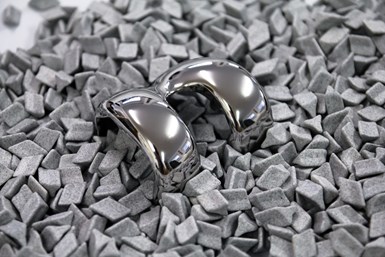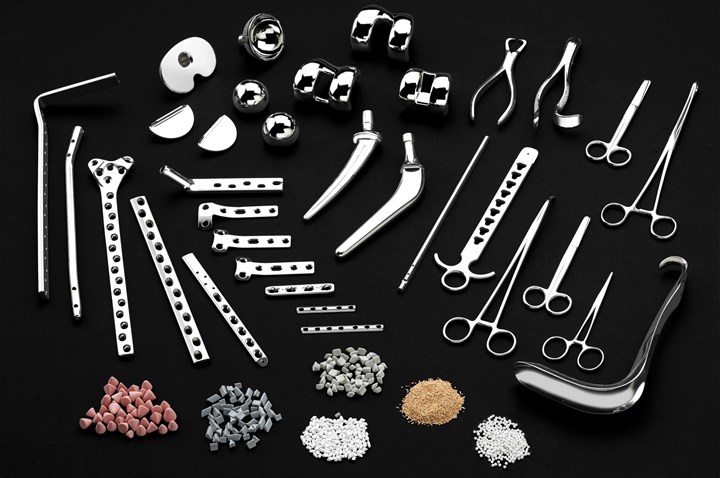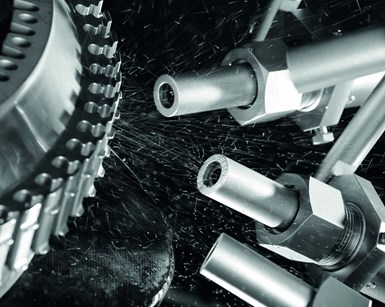
The gentle, controlled and consistent nature of mass finishing helps ensure uniform treatment of all surfaces.(Photo credits: Rösler)
In the aerospace and medical industries, mass finishing and shot blasting processes are critical for achieving a quality surface finish while ensuring the reliability and safety of critical components. These two distinct technologies used for surface finishing of components each have a unique method and application.
Mass finishing, which includes techniques such as tumbling, vibratory finishing and centrifugal finishing, involves placing parts in a machine with abrasive media, where they are finished through a combination of mechanical and chemical actions. This method is particularly effective for deburring, smoothing, polishing and cleaning a large number of small- to medium-sized parts simultaneously, making it well suited for intricate components with complex geometries. The gentle, controlled and consistent nature of mass finishing helps ensure uniform treatment of all surfaces.
Conversely, shot blasting uses the forceful projection of abrasive materials, such as steel or glass beads, against the surface of the component. This high-energy process is often used for cleaning, strengthening (peening) or roughening surfaces, often for larger, more robust components. Its aggressive nature makes it appropriate for removing heavy scale, rust or old coatings, and it is commonly used in industries such as aerospace and automotive for preparing surfaces for painting or coating.
The choice between mass finishing and shot blasting depends on the specific requirements of the application. Mass finishing is preferred for delicate, precision parts requiring uniform treatment, while shot blasting is chosen for its aggressiveness and suitability for larger, tougher components needing thorough surface preparation.

Mass finishing is widely used to smooth and polish implantable devices, surgical instruments and other medical tools.
In the medical industry, mass finishing, prior to final sterilization in accordance with applicable medical regulations, is essential for ensuring the safety and effectiveness of various devices. The process is widely used to smooth and polish implantable devices, surgical instruments and other medical tools. The primary objective is to eliminate any surface irregularities that could harbor bacteria or cause patient discomfort. For instance, mass finishing is vital in the production of orthopedic implants, where a smooth surface can significantly reduce the risk of tissue irritation and promote better integration with the body. Additionally, the process is used to clean and finish components of diagnostic equipment, ensuring that they are free of contaminants and safe for patient contact.
Shot blasting, in the context of the aerospace industry, is crucial for preparing component surfaces for further processing and ensuring their structural integrity. This process is extensively used for cleaning, texturizing or peening surfaces of aircraft components made of metals and alloys. By removing surface contaminants, shot blasting enhances the adhesion properties of subsequent coatings, which is critical for parts that are exposed to extreme environmental conditions. Moreover, shot blasting is used for stress-relieving and strengthening components through peening, a process that improves fatigue resistance and prolongs the lifespan of critical aerospace parts, such as turbine blades, landing gear and fuselage components.

Shot blasting, in the context of the aerospace industry, is crucial for preparing component surfaces for further processing and ensuring their structural integrity.
The importance of mass finishing and shot blasting in these sectors is underscored by their direct impact on safety and performance of safety-critical devices. In the medical field, the precise and gentle finishing of devices ensures device efficacy. In aerospace, the reliability and durability of components are non-negotiable, with shot blasting playing a pivotal role in ensuring these attributes. These processes not only contribute to the longevity and functionality of components, but are also integral in complying with stringent industry standards and regulations, thereby upholding the highest safety benchmarks in these critical sectors.
Rösler AG offers solutions for mass finishing and shot blasting in the aforementioned industries and others. It offers a variety of mass finishing machines, such as tumblers, vibratory finishers and centrifugal equipment, as well as an array of shot blasting machines suited for applications ranging from gentle peening to aggressive surface cleaning. Equally important is the company’s experience in selecting the proper media to achieve optimal results, whether it be ceramic, plastic or metallic for mass finishing, or the appropriate abrasives for shot blasting, to achieve optimal results.
Rösler also focuses on offering automated and turnkey finishing solutions per a manufacturer’s specific needs. These can include everything from initial consultation and machine design to installation and commissioning.
About the author: Colin Spellacy is head of sales for Rösler UK.
Related Content
T.J. Davies Retention Knobs Harden Over Time
Each retention knob is magnetic particle tested and pull tested to 2.5X the pulling force of the drawbar it is designed for.
Read MoreForkardt Hardinge Swiss Workholding Provides Reliable, Consistent Performance
The company’s Swiss collets are designed to securely hold parts without marring surfaces, minimizing vibration to ensure smoother machining, enhanced accuracy and extended tool life.
Read MoreHow Small Machine Shops Can Fight Supply Chain Problems
Supply chain disruptions are still presenting challenges in manufacturing. This article examines the effects on aerospace, automotive and medical industries. It also covers ways that machine shops can be successful securing work despite the challenges created by the supply chain.
Read MoreJR Machine Launches Expansion Strategy, Hires New CEO
An investment from Schneider Resources Holding positions JR Machine to grow in emerging markets such space exploration and green energy.
Read MoreRead Next
5 Aspects of PMTS I Appreciate
The three-day edition of the 2025 Precision Machining Technology Show kicks off at the start of April. I’ll be there, and here are some reasons why.
Read MoreEmerging Leaders Nominations Now Open
Here’s your chance to highlight a young person in your manufacturing business who is on the path to be a future leader moving your company forward.
Read MoreDo You Have Single Points of Failure?
Plans need to be in place before a catastrophic event occurs.
Read More






















